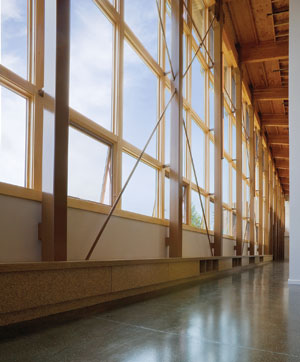Fenestration Innovations for Leaner, Greener Times
Prescriptive vs. Performance
In applying innovative fenestration technologies, architects are served best by understanding applicable energy codes and green building standards, both required and voluntary. Compliance paths are varied, but in many of the codes and programs include both prescriptive and performance-based options.
The IGCC, for example, is written in mandatory language that allows jurisdictions to specify enhanced performance levels in very specific areas of concern. For energy systems, buildings over 25,000 square feet must use the performance-based energy compliance path, which exceed the 2012 IECC; projects smaller than that can be designed using prescriptive or performance based compliance. Fenestration requirements, however—which are covered in IGCC Section 606, along with U-factor alternatives, air infiltration and other building thermal envelope features—apply to the prescriptive-based compliance path only.
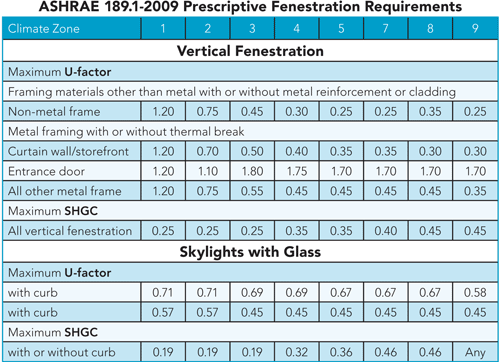 |
Source: CommercialWindows.com |
In general, the IGCC's requirements affecting fenestration include energy conservation levels, air infiltration rates, daylighting measures and total renewable energy, which may include BIPV fenestration systems, glazings and the like. All fenestration must comply with the 2012 IECC limits on air leakage. For the prescriptive path, the total building envelope system (including fenestration) must beat the 2012 version of IECC by 10 percent or better, and it must have permanent shading on all but the north façades.
The IGCC also gives ASHRAE 189.1 (officially known as the ASHRAE/USGBC/IES Standard 189.1-2009) as an optional compliance path, which allows for a performance-based assessment of building energy efficiency using modeling software or a prescriptive path with a maximum allowed fenestration area (40 percent of exposed exterior walls) and minimum performance levels for such fenestration variables as air leakage rates, SHGC and U-factor.
The prescriptive levels in ASHRAE 189.1—and, by extension, in the IGCC—are viewed by some as quite aggressive. For example, in climate zones 1, 2 and 3, where air-conditioning loads predominate, permanent shading devices must be installed and the maximum allowed fenestration area on east- and west-facing exposures must not exceed a specific limit depending on how much fenestration area is on the north and south exposures. In all situations, skylight area may not exceed 5 percent of total roof area, but daylighting using skylights must exceed a certain minimum level in certain large interior volumes.
That's not all. Windows and skylights may not have air leakage rates greater than 0.4 cfm per square foot. There are also minimum SHGC requirements that take into account building-integrated shading and skylights used for daylighting. Further, occupancies such as schoolrooms and offices must provide a minimum effective aperture for vertical fenestration (EAvf), which can be met by using high-VLT fenestration or by increasing glazing area, or both.
In the 2012 IECC, mandatory air leakage maximums are given for both the prescriptive and performance versions. If the prescriptive path is elected, there are specific requirements and levels for SHGC, U-factor and total fenestration area – 30 percent, unless daylighting design is integral to the building enclosure. The use of automated controls for daylighting increases the allowed areas for windows, skylights and the like, but only if more than half of the interior floor area is designed for daylighting and if the fenestration VLT is at least 1.1 times the SHGC, according to the the University of Minnesota's Center for Sustainable Building Research (www.commercialwindows.org) in Minneapolis.
Underlying all of the fenestration requirements in the IECC, IGCC and ASHRAE 189.1 are fenestration energy ratings, which are set forth and promulgated by NFRC. Any testing lab that meets NFRC standards can certify the product ratings, according to Center for Sustainable Building Research. “Regardless of the chosen compliance path, the following fenestration energy properties are critical for compliance with the code: U-factor, solar heat gain coefficient (SHGC), air leakage, and possibly visible transmittance,” according to the research site established by the university with Lawrence Berkeley National laboratories.
Case Studies of Fenestration Innovations
Looking to the prescriptive code minimum of IECC or the more ambitious performance targets in the IGCC—as well as the new ICC fire ratings for glass—architects around the country are using innovative fenestration technologies and design techniques to create sustainable, energy-efficient and safe buildings. A number of new case studies provide examples of the goals and application strategies.
| Glass Product Selection Criteria |
Radiant energy transfer is the key to the selection of glazed fenestration. Four properties contributing to radiant energy transfer are transmittance, emittance, reflectance and absorptance. As its name suggests, emittance is the property that is addressed by low-emissivity (low-E) glass. Yet all areas of a window assembly or curtain wall may affect the types of performance expected for radiant energy transfer. Three of the four properties also contribute to the overall performance of glazed fenestration:
|
| Fire-Rated, Energy-Efficient IGUs: Sapphire Towers, San Diego |
The designer and owner of this luxury high-rise condominium in San Diego hoped to offer panoramic views of the bay and waterfront, with the largest possible window openings. Yet, the building's south elevation was too close to the adjacent property and required a solid—and presumably opaque—enclosure system. As an alternative, the code allowed glazed openings with a minimum 45-minute fire rating on all 32 floors. The architect, AVPR Studios, selected fire-rated, NFRC-certified assemblies on all floors, meeting both the fire and energy requirements using just one system—182 units in all, ranging from 48 by 90 inches to 82 by 130 inches in size. The outboard lite is a 1/4-inch blue glass matching the rest of the tower, but on the south façade it is combined with a 3/4-inch, 45-minute-rated glass with a low-E coating on the No. 3 surface. The assembly uses fire-resistive GPX framing with aluminum covers, finished in a silver powder coat for the exterior side and white powder coat for the interior side to match all the non-rated framing used in the project. The general contractor, Swinerton Builders, and the glass installer requested the IGUs be delivered as preassembled, modular units to improve quality control and reduce risk on the job site. |
| Aluminum-Clad Wood Awning Windows: Environmental Nature Center, Newport Beach, Calif. |
||
As the first LEED Platinum building in California's Orange County—and one of only 10 or so Platinum certificants in the entire state—the 9,000-square-foot, $4.2 million, nonprofit Environmental Nature Center (ENC) is an educational facility focused on exposing the natural world to visitors. With that in mind, the architect and ENC board hoped to make the building a showplace of sustainability and energy efficiency. Using a palette of recycled and recyclable materials including insulation from old blue jeans and a composite wood skin made of organic sawdust and natural resin, the architects at LPA in Irvine, Calif., created a stunningly simple shed roof with expanses of large operable and fixed aluminum-clad, wood awning windows to create a window wall. To keep the project on its tight budget, the architects had planned to orient the building east-west to capture natural ventilation through the building—enough to completely eliminate the need for heating and air-conditioning. The window wall and outswing doors used for the project were specified and designed, with help from the manufacturer, as fixed and operable casement and awning windows with natural wood interiors and custom-color, low-maintenance aluminum-clad exteriors. An advanced, low-E insulating glass design with a green tint was selected to reduce glare and solar heat gain while maximizing visible light transmission. Overall, the fenestration design helped earn the project LEED points for energy efficiency and IEQ. |
Notice
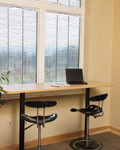
www.sunguardglass.com
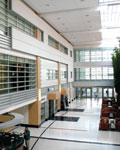
www.safti.com
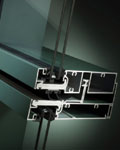
www.efcocorp.com





